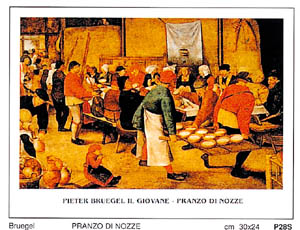Pranzo di nozze Brueghel

Poster Brueghel Pranzo di nozze - 30x24 cm
| Code | Masse in cm | Grammatur in m2 | Preis € |
Bestell- menge |
||
|---|---|---|---|---|---|---|
| Blatt | ||||||
Pranzo di nozze Brueghel -
Pieter Bruegel the Elder (Dutch pronunciation: [?pit?? ?b?ø???l]; c. 1525 – 9 September 1569) was a Flemish Renaissance painter and printmaker known for his landscapes and peasant scenes (Genre Painting). He is sometimes referred to as "Peasant Bruegel" to distinguish him from other members of the Brueghel dynasty, but is also the one generally meant when the context does not make clear which "Bruegel" is being referred to. From 1559 he dropped the 'h' from his name and started signing his paintings as Bruegel.
Life
There are records that he was born in Breda, Netherlands, but it is uncertain whether the Dutch town of Breda or the Belgian town of Bree, called Breda in Latin, is meant. He was an apprentice of Pieter Coecke van Aelst, whose daughter Mayken he later married. He spent some time in France and Italy, and then went to Antwerp, where in 1551 he was accepted as a master in the painter's guild. He traveled to Italy soon after, and then returned to Antwerp before settling in Brussels permanently 10 years later. He received the nickname 'Peasant Bruegel' or 'Bruegel the Peasant' for his alleged practice of dressing up like a peasant in order to mingle at weddings and other celebrations, thereby gaining inspiration and authentic details for his genre paintings. He died in Brussels on 9 September 1569 and was buried in the Kapellekerk. He was the father of Pieter Brueghel the Younger and Jan Brueghel the Elder. Both became painters, but as they were very young children when their father died, it is believed neither received any training from him. According to Carel van Mander, it is likely that they were instructed by their grandmother Mayken Verhulst van Aelst, who was also an artist.
Style
In Bruegel's later years he painted in a simpler style than the Italianate art that prevailed in his time. The most obvious influence on his art is the older Dutch master Hieronymus Bosch, particularly in Bruegel's early "demonological" paintings such as The Triumph of Death and Dulle Griet (Mad Meg). It was in nature, however, that he found his greatest inspiration as he is identified as being a master of landscapes. It was in these landscapes that Bruegel created a story, seeming to combine several scenes in one painting. Such works can be seen in The Fall of the Rebel Angels and the previously mentioned The Triumph of Death.
Themes
Bruegel specialized in genre paintings populated by peasants, often with a large landscape element, but also painted religious works. Making the life and manners of peasants the main focus of a work was rare in painting in Brueghel's time, and he was a pioneer of the Netherlandish genre painting. His earthy, unsentimental but vivid depiction of the rituals of village life—including agriculture, hunts, meals, festivals, dances, and games—are unique windows on a vanished folk culture and a prime source of iconographic evidence about both physical and social aspects of 16th century life. For example, the painting Netherlandish Proverbs illustrates dozens of then-contemporary aphorisms (many of them still in use in current Dutch or Flemish), and Children's Games shows the variety of amusements enjoyed by young people. His winter landscapes of 1565 (e.g. Hunters in the Snow) are taken as corroborative evidence of the severity of winters during the Little Ice Age.
Using abundant spirit and comic power, he created some of the early images of acute social protest in art history. Examples include paintings such as The Fight Between Carnival and Lent (a satire of the conflicts of the Reformation)[citation needed] and engravings like The Ass in the School and Strongboxes Battling Piggybanks. On his deathbed he reportedly ordered his wife to burn the most subversive of his drawings to protect his family from political persecution.
